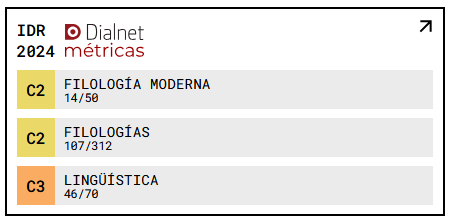Moulding Malvolio into Modern Adaptations of “Twelfth Night”
DOI:
https://doi.org/10.18172/jes.3553Keywords:
Malvolio, characterization, popular culture, adaptations, audience expectation, “Twelfth Night”Abstract
This paper explores how target-audience expectations and generic limitations on modern, mass-culture adaptations of Shakespeare’s comedy Twelfth Night mould the characterization of his officious steward Malvolio, and dictate the degree of centrality that his subplot holds in each different version. A trans-generic application of Shlomith Rimmon-Kenan’s work on characterization will expose how the character of Malvolio is constructed and presented, first in the original play and then in three modern adaptations of Twelfth Night into different popular genres. The works selected for contrastive analysis with the original play each represent different generic fields found on today’s mass-culture market – romance fiction, teen cinema and the web-comic. Respectively, they are: The Madness of Love, a contemporary romance novel by Katharine Davies, published in 2005; She’s the Man, a Hollywood teen film directed by Andy Fickman in 2006; and a web-comic retelling of Twelfth Night by Mya Lixian Gosling, which was published on her website Good Tickle-Brain Shakespeare in 2014.
Downloads
References
Cahill, E. 1996. “The Problem of Malvolio”. College Literature 23 (2): 62-83.
Davies, K. 2004. The Madness of Love. London: Vintage.
Draper, J. W. 1950. The Twelfth Night of Shakespeare’s Audience. Stanford: Stanford University Press.
Fickman, A. dir. 2006. She’s the Man. Canada and USA: Dreamworks Studios, Lakeshore Entertainment, and Donners’ Company.
Gosling, M. 2017. “Good Tickle-Brain Shakespeare” 2017. http://www.goodticklebrain.com/. (Accessed 3 April 2017)
Hanţiu, E. 2012. “She’s the Man: Gender Dynamics in William Shakespeare’s Twelfth Night”. Gender Studies 11 (1): 100-113. https://doi.org/10.2478/v10320-012-0031-8.
Kemper, Becky. 2007. “A Clown in the Dark House: Reclaiming the Humor in Malvolio's Downfall”. Journal of the Wooden O Symposium 7: 42-50.
Jorgens, Jack. 1998. “Realising Shakespeare on Film”. Shakespeare on Film. Ed. R. Shaughnessy. London: Macmillan. 18-42.
Lanier, D. 2002. Shakespeare and Modern Popular Culture. Oxford: Oxford University Press.
Lanier, D. 2018. “Shakespearean Comedy on Screen”. The Oxford Handbook of Shakespearean Comedy. Ed. H. Hirschfeld. Oxford: Oxford University Press. 470-488.
Minami, R. 2016. “Hello Sha-kitty-peare?: Shakespeares Cutified in Japanese Anime Imagination”. Journal for Early Modern Cultural Studies 16 (3): 116-137.
Osborne, L. E. 2008. “Twelfth Night’s Cinematic Adolescents: One Play, One Plot, One Setting, and Three Teen Films”. Shakespeare Bulletin 26 (2): 9-36.
Perret, M. D. 2004. “Not Just Condensation: How Comic Books Interpret Shakespeare”. College Literature 34 (4): 72-93.
Rimmon-Kenan, S. 2003. Narrative Fiction. London and New York: Routledge.
Sanders, J. 2006. Adaptation and Appropriation. London and New York: Routledge.
Shakespeare, W. and K. Elam. 2008. Twelfth Night. Bloomsbury: The Arden Shakespeare. (Original work published in the First Folio in 1623).
Tichenor, A. 2016. “Episode 493: Good Tickle Brain”. Reduced Shakespeare Company Podcast from Reduced Shakespeare. http://www.reducedshakespeare.com/2016/05/episode-493-good-tickle-brain/. (Accessed 10 March 2017)
Walia, D. 2017. “Re-reading Twelfth Night through Hollywood Adaptation She’s the Man”. Pune Research. An International Journal in English 3 (5): 1-6. http://puneresearch.com/media/data/issues/59d285c1d71f8.pdf. (Accessed 25 April 2019)
Downloads
Published
How to Cite
Issue
Section
License
The authors retain copyright of articles and authorize Journal of English Studies the first publication. They are free to share, redistribute, and/or reprint the article without obtaining permission from the publisher as long as they give appropriate credit to the editor and the journal.
Self-archiving is allowed too. In fact, it is recommendable to deposit a PDF version of the paper in academic and/or institutional repositories.
It is recommended to include the DOI number.
This journal is licensed under a Creative Commons Attribution 4.0 International License













